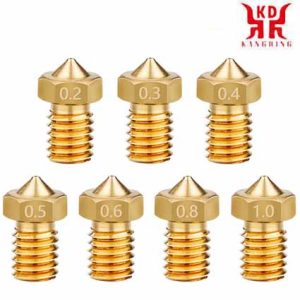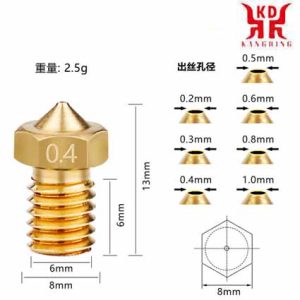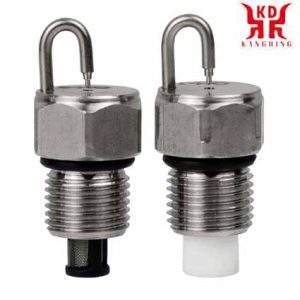
Vlastné neštandardné špeciálne tryskyshat je tryska? Technológia CNC obrábania trysky
Čo je tryska? Technológia CNC obrábania trysky
Tryska je navrhnutá tak, aby fungovala v rôznych podmienkach striekania, preto si vyberte trysku, ktorá vyhovuje vašim potrebám, aby ste dosiahli najlepší výkon pri používaní. Charakteristiky dýzy sa odrážajú najmä v type rozprašovania dýzy, to jest, tvar vytvorený, keď kvapalina opustí ústie dýzy a jej prevádzkový výkon. Názov trysky vychádza z tvaru spreja rozdeleného na vejár, kužeľ, prietok kvapalinovou kolónou (tj prúdové lietadlo), atomizácia vzduchu, a plochá tryska. Medzi nimi, kužeľová dýza je rozdelená do dvoch kategórií: dutý kužeľ a plný kužeľ; Tryska je veľmi kľúčovým komponentom pri mnohých druhoch striekania, striekanie oleja, pieskovanie a ďalšie vybavenie, a hrá dôležitú úlohu.
Výber trysky
Pretože dýza je navrhnutá tak, aby fungovala v rôznych podmienkach striekania, tryska vhodná pre potreby je zvolená tak, aby sa dosiahol najlepší striekací výkon pri použití. Charakteristiky dýzy sa odrážajú najmä v type rozprašovania dýzy, to jest, tvar vytvorený, keď kvapalina opustí ústie dýzy a jej prevádzkový výkon. Názov trysky je, že tvar spreja je rozdelený na ventilátor, kužeľ, prietok kvapalinovou kolónou (tj prúdové lietadlo), atomizácia vzduchu, a plochá tryska. Kužeľová tryska je rozdelená do dvoch kategórií: dutý kužeľ a plný kužeľ;
Faktory pre výber trysiek zahŕňajú prietok, tlak, uhol rozprašovania, pokrytie, nárazová sila, teplota, materiál, aplikácie, atď., a tieto faktory spolu často súvisia a navzájom sa obmedzujú. Prietok a tlak, uhol striekania a pokrytie sú navzájom úmerné. Účelom akéhokoľvek prúdu trysky je udržiavať nepretržitý kontakt medzi kvapalinou kúpeľa a obrobkom, a faktor prietoku je dôležitejší ako tlak. Teplota kvapaliny neovplyvňuje výkon rozprašovania trysky, ale ovplyvňuje viskozitu a špecifickú hmotnosť, a ovplyvňuje aj výber materiálov.

Špirálová tryska z nehrdzavejúcej ocele
Výber materiálu trysky
Materiál dýzy by sa mal tiež určiť podľa chemických charakteristík kúpeľa:
1. Pre nekorozívne kúpele, podľa náročnosti spracovania možno použiť bronzový odliatok alebo plastový odliatok;
2. Aby sa zabránilo korózii, možno použiť nekovové materiály;
3. Nylonové plasty môžu byť použité pre silné korozívne kúpele, ako je kyselina sírová a kyselina chlorovodíková;
4. Materiál dýzy použitý pre fosfátovací kúpeľ je vo všeobecnosti nehrdzavejúca oceľ odolná voči kyselinám;
5. The nozzle to prevent corrosion can also be made of stainless steel or nylon.
Nozzle selection method
For nozzles with a certain impact force, small-angle nozzles should be selected, and liquid column flow (ie jet flow) is the best;
Fan-shaped nozzles are suitable for cleaning, degreasing, chladenie, atď., cone-shaped nozzles are suitable for rinsing, surface layer, fosfátovanie, humidification, dust removal, atď.;
For the nozzles of degreasing and washing processes, the jet nozzles with stronger impact force can be selected: Take the “V”-type or fan-shaped nozzle as an example, the spray angle of 60° is the best, which has a large impact force;
For the nozzle of the phosphating process, a centrifugal nozzle with good atomization, fine and uniform water particles, and weak impact force can be selected: Take the “Z” type or cone nozzle as an example, the best distance between the nozzle and the workpiece is 40cm-50cm, It has the spray effect of dispersing and atomizing the liquid.

Conical copper nozzle structure
Quality inspection of nozzles
The nozzle needs to be repaired, regularly inspected, cleaned and even replaced in order to ensure the quality of the final product and maintain the economic benefits of the production process. The method and frequency of maintenance procedures depend on the application. The maintenance plan can be arranged according to the purpose, liquid and nozzle material.
There are seven common causes that affect nozzle spray problems:
a) Corrosion and wear: The material on the surface of the nozzle orifice and the internal flow channel gradually becomes larger or deformed, which in turn affects the flow rate, pressure and spray shape.
b) Corrosion: The chemical action of the spray liquid or the environment causes corrosion and damages the nozzle material.
c) Blocking: Dirt or other impurities in the liquid block the nozzle mouth, thus restricting the flow rate of the nozzle and disturbing the spray shape and its uniformity.
d) Bonding: The spray, mist or chemical accumulation on the material inside or outside the edge of the nozzle caused by the evaporation of the liquid can leave a dry solidified layer and block the nozzle or internal flow channel.
e) Temperature damage: Overheating will have certain damaging effects on nozzle materials designed for non-high temperature applications.
f) Incorrect installation: Washers that deviate from the axis, over-tightening, or other changes in position can have adverse effects.
g) Accidental damage: During installation and cleaning, the nozzle may be accidentally damaged due to the use of incorrect tools.
The structure of the nozzle
Different nozzle structures will lead to differences in processing efficiency and nozzle life. Reasonable nozzle structure enables the abrasive to obtain high speed, which is a necessary condition for improving the processing efficiency and reducing the cost. From the advent of the nozzle to a long period afterwards, the cylindrical nozzle structure was adopted. Doteraz, there are various nozzle structures developed at home and abroad. The fuel nozzle is equipped with an electromagnetic coil, an iron core and a needle valve integrated with the iron core. The structure types and characteristics of commonly used nozzles are shown in the following table
1. Cylindrical straight hole nozzle structure
Schematic diagram of cylindrical straight hole nozzle structure. It has both functions of spray gun and nozzle, and has a simple structure. It can be directly replaced by seamless steel pipe, or it can be obtained by drilling in the material, but the nozzle life is short, and it is mostly used in occasions where sandblasting is not required.
2. Conical nozzle structure
A schematic diagram of the structure of a cone-shaped nozzle. This nozzle structure has a cone-shaped inlet with a diversion function and a straight section that serves as a bundling function. It is relatively easy for the abrasive to enter the nozzle, and the distribution of the abrasive on the nozzle section is more uniform than that of a cylindrical nozzle.
3. Special nozzle
Špeciálna tryska na pieskovanie s dvojitým výstupom, komplexná štruktúra, bežne používané pri zvláštnych príležitostiach, ako je pieskovanie vnútornej steny potrubia
4. Kombinovaná štruktúra trysky
Dizajnové materiály s rôznymi vlastnosťami na vstupe dýzy, vývod a stredná časť, a zostaviť každú časť materiálu do dýzy mechanickou kombináciou. Kombinovaná tryska je navrhnutá s vysokotvrdou keramikou alebo inými materiálmi odolnými proti opotrebovaniu na vstupe a výstupe trysky. Stredná časť dýzy môže byť navrhnutá z kovu s vysokou húževnatosťou alebo z iných materiálov. Kombinovaná tryska môže spĺňať rôzne požiadavky na vstup trysky, výstupné a stredné časti protieróznej a opotrebovanej výkonnosti. Do istej miery, zlepšuje sa odolnosť dýzy proti erózii, ale v porovnaní s monolitickou dýzou, je potrebné pripraviť dva alebo viac materiálov, a súvisiace procesy, ako je montáž, sa zvyšujú.

Mikro tryska
Oblasti použitia trysiek
1. Vozidlá, kontajnerové spoločnosti: klipové trysky, atď.
(1) V predúprave striekacej linky, defosforizácia, odmasťovanie a odstraňovanie hrdze;
(2) Dažďová línia slúži hlavne na zistenie, či je výrobok dobre utesnený
2. Papierový mlyn
(1) Odpeňovacie trysky, na odstránenie peny v dužine, používajú sa dýzy s dutým kužeľom a špirálové dýzy;
(2) Náterová tryska, čo je povrchová úprava papiera, sa používa na poťahovacom stroji na atomizáciu dýzy;
(3) Tryska s vodnou ihlou používaná na rezanie papiera, to jest, ihlová tryska, vyžaduje vysoký tlak na prácu, a musia byť vykladané keramikou alebo vysokými zliatinami;
(4) Ihlové dýzy a ventilátorové dýzy sa vo všeobecnosti používajú na čistenie dýz tkaniny sieťovej klietky, a trysky sú samočistiace;
(5) Slurry drawing nozzle, narrow-angle nozzle is used:
3. Textile industry: atomized nozzle
(1) Humidification of workshops, especially under the conditions of high dust in textile mills, cotton spinning, weaving, wool tops, towels;
(2) Add a kind of pine flower oil to the wool yarn to prevent the wool yarn from drying and breaking;
4. Electronics
(1) The large space of a large electronic factory is humidified and cooled, using atomized nozzles;
(2) Cleaning nozzles for electronic boards, fan-shaped, wide-angle, and quick-release nozzles;
(3) The application of the rosin nozzle after the circuit board is formed, spraying the rosin to protect the circuit board;
(4) The circuit board is useful for the nozzle of Saigang;

Spray nozzle of humidifier
5. Pharmaceutical factory: atomizing nozzle
(1) Granulation nozzle,
(2) Náterová tryska, to jest, the sugar coating on the surface of the medicine;
6. Food industry:
(1) Cleaning of mustard tuber;
(2) Washing of fruits, vegetables, atď., such as washing and hair removal of strawberries;
(3) The purification workshop has an air shower room and air shower nozzles are used;
7. Thermal power plant
(1) Large-flow nozzles, such as silicon carbide nozzles and spiral nozzles, are used for desulfurization and dust removal;
(2) Used in the cooling system before the boiler;
8. Garbage disposal
(1) Use an atomizing nozzle to spray a spice on the garbage to get rid of the peculiar smell;
(2) Use nozzles such as solid cones to reduce dust;
9. Radiator: because of the spraying treatment, it is useful for clip nozzles;
10. Steel pipe factory: wide-angle and multi-component paint nozzles made of titanium;
(1) High-pressure derusting nozzles used in steel pipe factories;
(2) Coated nozzles inside and outside the steel pipe;
11. For pressure vessel factories, používajú sa pevné kužeľové dýzy.
12. Vinárstvo
(1) Trysky na krásu a trysky na hmlu na kozmetických strojoch, ako je pivo a víno
(2) Multitryska alebo rotačná tryska na čistenie fliaš;
13. Ropný a chemický priemysel
(1) Čistiace trysky na fľaše a plechovky, viachlavové alebo rotačné trysky;
(2) Chladiace trysky na fľaše a plechovky;
(3) Aby plne odrážali chemické látky, používa sa dýza zložená z plášťa a vnútorného jadra
14. Chladiaca veža: použite trysky s veľkým prietokom, ako sú klipové trysky, špirálové trysky, atď.;
15. Zariadenie na sušenie: sprejové alebo atomizačné sušiace zariadenie používa vzduchové rozprašovacie trysky alebo kovové mikrorozprašovacie trysky.
16. Sušenie dreva: trysky sa používajú na zabránenie praskaniu dreva;
17. Odstraňovanie prachu, odstránenie dymu, čistenie odpadových plynov;
(1) Používa sa v zberači prachu alebo zariadení na mokré vlasy;
(2) Na čistenie odpadového dymu a odpadového plynu niektorých podnikov, všeobecne sa používajú veľké prietokové dýzy;
18. Mazanie:
(1) Mazanie ozubených kolies;
(2) Striekanie separačného prostriedku na striekacie zariadenie;
(3) Mazanie oceľového lana;
(4) Mazanie zápustky na veľkom kovacom lise;
 English
English العربية
العربية 中文(漢字)
中文(漢字) Čeština
Čeština Dansk
Dansk Nederlands
Nederlands Suomi
Suomi Français
Français Deutsch
Deutsch Italiano
Italiano 日本語
日本語 ಕನ್ನಡ
ಕನ್ನಡ 한국어
한국어 Português
Português Русский
Русский Slovenčina
Slovenčina Español
Español Svenska
Svenska Türkçe
Türkçe

